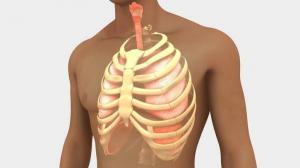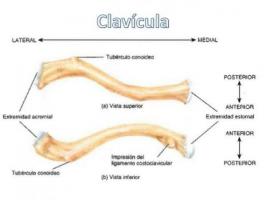What is tracheal breathing
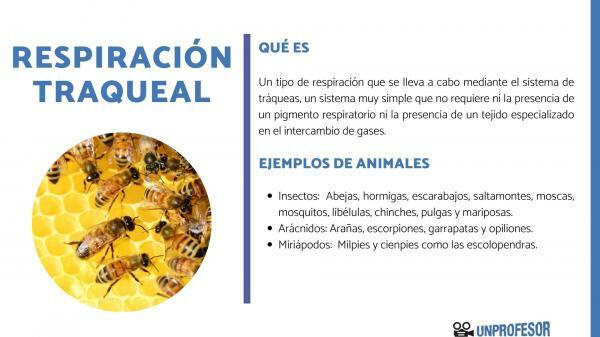
In insects and other terrestrial arthropods (arachnids and myriapods), external respiration is airborne. That is, the exchange of gases with air occurs. This gas exchange takes place through a system of internal conduits called tracheas and is called tracheal breathing. In this lesson from a TEACHER you will discover what is tracheal respiration and animal examples who use this type of external respiration.
Index
- Tracheal respiration, a type of animal respiration
- What animals use tracheal respiration? Arthropods
- Examples of animals with tracheal respiration
- How is tracheal breathing
- Functioning of tracheal breathing
- Respiration in the largest insects
Tracheal respiration, a type of animal respiration.
The breathing it is a metabolic process that occurs in the mitochondria of the ecukaryotic cell. It consists of the use of O2 (oxygen) to obtain energy and produces CO2 (carbon dioxide) as a waste substance. At the physiological level (at the level of the animal as a whole) the process of cellular respiration is reflected in the
external respiration which consists of the exchange of gases that occurs between the body and the environment.Although cellular respiration is the same in the cells of all organisms that carry out the aerobic respiration (which uses oxygen from the air), there are several types of external breathsIn terrestrial vertebrates, gas exchange takes place through the lungs, in the case of fish that perform aquatic respiration, they use gills. In both cases the respiratory system requires several essential elements:
- Existence of a tissue specialized in gas exchange, which is called respiratory tissue. In the case of terrestrial vertebrates, the respiratory tissue is what forms the lungs, in the case of fish this tissue is what constitutes the gills.
- Presence of a respiratory pigment: these are the pigments used to transport oxygen from the respiratory tissue to the tissues. An example of a respiratory pigment is hemoglobin, which binds to oxygen to transport it in the blood and gives it its characteristic red color.
However, the respiratory system of terrestrial insects and other arthropods is totally different. These organisms use the trachea system, a very simple system that requires neither the presence of a respiratory pigment nor the presence of a specialized tissue in the gas exchange.
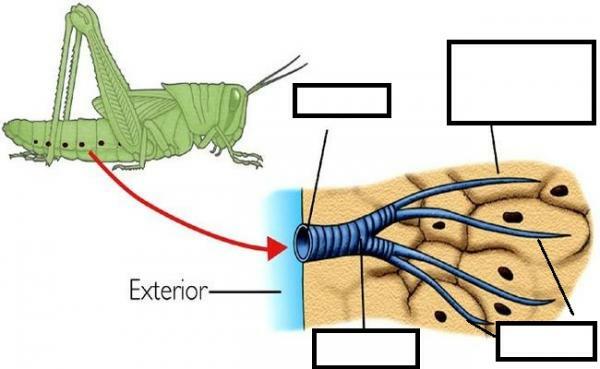
Image: Educaplay
What animals use tracheal respiration? Arthropods.
As we have already pointed out in the previous section, the organisms that use tracheal respiration are terrestrial arthropods.
The arthropods they are the most abundant group of animals, both in number of species and in number of individuals. 80% of all known animal species are arthropods. These figures are a reflection of its great evolutionary success.
Arthropods are invertebrates, that is, they do not have an articulated internal skeleton. I know characterize for:
- Be endowed with a exoskeleton or cuticle (outer covering) with movable jointed appendages (limbs). The exoskeleton is made up of chitin and other proteins. Chitin is a hard, waterproof and extremely light substance.
- Be organisms segmented. That is, they are made up of segments that are functional units.
- They have a system of open circulation where the hemolymph.
- They grow through silent completely renovating their exoskeletons.
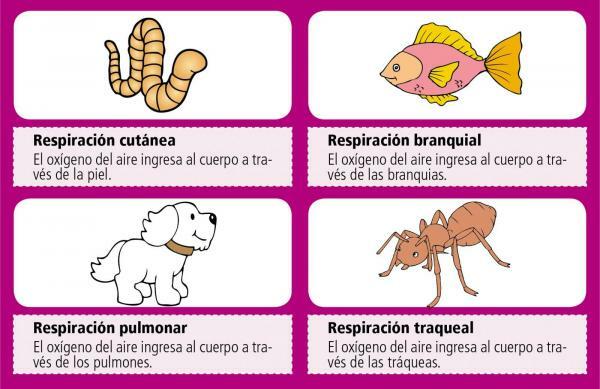
Image: ABC Color
Examples of animals with tracheal respiration.
Within the terrestrial arthropods are the myriapods, arachnids and insects. Therefore, the examples of animals with tracheal respiration are the following:
- Insects: They have the body divided into three parts (head, thorax and abdomen), three pairs of legs. They have a pair of antennas. Examples: Bees, ants, beetles, grasshoppers, flies, mosquitoes, dragonflies, bed bugs, fleas, and butterflies.
- Arachnids: They have a body divided into two parts (prosoma and opistosome), four pairs of legs, they lack antennae and instead of jaws they have two appendages called chelicerae on both sides of the mouth. Examples: Spiders, scorpions, ticks, and opilions.
- Myriapods: They have a pair of antennae and a trunk made up of numerous segments. Examples: Millipedes and centipedes like scolopendras.

How is tracheal breathing.
The tracheal system consists of a system of tubes filled with air that penetrates from the body surface to the cells. The tracheathey are invaginations (inward folds) of the body surface that branch and interconnect throughout the body. Its walls have a composition similar to the cuticle (exoskeleton of insects) and are quite rigid.
Tracheolas are the smallest branches of the tracheae, are closed at the end and end in direct contact with the individual cells, supplying oxygen in areas very close to the mitochondria (organelles responsible for respiration mobile). The total area of the tracheoles is very large.
In general, the more active tissues (such as the muscles that insects use to fly) have more tracheoles.
The breathing system through the trachea
Tracheolar fluid fills the end of the tracheoles except in a few species. Gases diffuse through this liquid.
Air sacks are widenings of the tracheal tubes that appear at various intervals. These widenings enlarge the tracheal volume by increasing the amount of oxygen available.
Spiracles they protect the tracheal entrances, except in the most primitive forms of insects. The presence of spiracles has several functions:
1. Regulate the flow of air in the tracheae.
2. They avoid the loss of water.
3. They protect the tracheal system from dust particles.
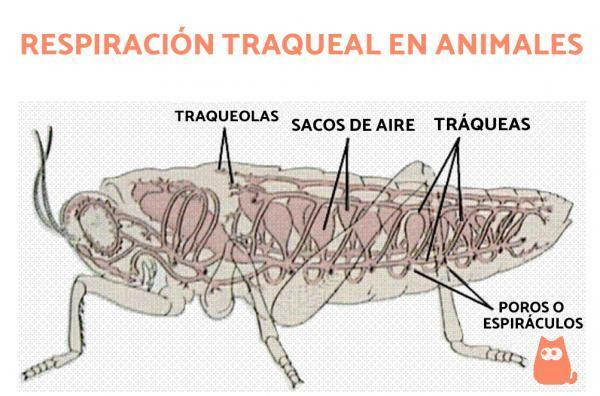
Functioning of tracheal respiration.
Through the air, O2 and CO2 spread very quickly from areas where its concentration is higher to areas with less concentration. Thanks to the rapid propagation, these gases move very fast in the tracheal system tube network. The rapid movement of oxygen and carbon dioxide through the tracheal system avoids the need for a circulatory system to transport gases.
Tracheoles are very abundant so that, only rarely, more than three cells are found around a tracheol.
Oxygen from the air that has entered the tracheal system travels through the network of tubes to the tracheoles. There the O2 is transferred from the air to the tissues through the very thin walls of the tracheoles, reaching the interior of the cells that are a short distance away.
In the opposite direction, the CO2 generated by the cells during respiration diffuses through the cell membranes and the wall of the tracheolus until reaching the interior of this from where will scroll by broadcast until it is expelled to the outside through the spiracles.
Respiration in the largest insects.
Larger insects generally have mechanisms to generate an air flow in the largest tubes of the tracheal system. Thus, stagnation is avoided of the air that would suppose the decrease in the oxygen concentration and the increase of the CO2 concentration.
In many cases, the tracheas and air sacs can be compressed allowing the tracheal volume to vary. The ventilation of the tubes of the tracheal system is carried out by means of alternative expansions and compressions of the exoskeleton, particularly that of the abdomen. The different spiracles can be opened or closed during the different expansion and compression phases of the respiratory cycle, thus controlling the direction of the air flow.
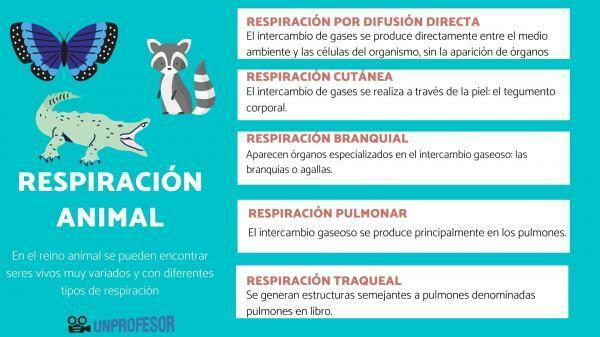
If you want to read more articles similar to Tracheal respiration: examples in animals, we recommend that you enter our category of biology.
Bibliography
- Eckert D. Randall; W. Burggen; K. French; R. Fernald (Col.). (1998)Animal physiology. Mechanisms and adaptations. Madrid: McGraw-Hill / Interamericana
- Richard C. Brusca, Gary J. Brusca; with illustrations by Nancy Haver; Spanish edition by Fernando Pardos Martínez (2005) Invertebrates Madrid: McGraw-Hill Interamericana

